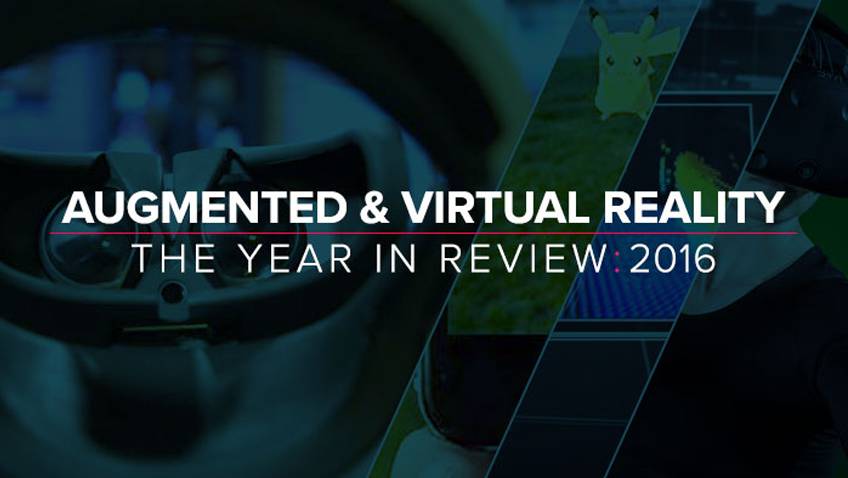
For a look ahead, check out the 5 top Virtual Reality and Augmented Reality technology trends for 2017. And for more information on how retailers are using mixed commerce solutions, check out our Mixed Commerce Glossary, which defines the terminology being used by businesses to describe the changes currently sweeping retail.
2016 was a breakthrough year for Augmented and Virtual Reality
2016 arrived with much promise. New consumer hardware from Oculus and HTC was on the horizon, and the buzz was that Virtual Reality was about to make a major leap into mainstream consciousness. As I sit here writing this on the precipice of 2017, it’s safe to say that the year turned out to be bigger, better, and even more surprising than the prognosticators had imagined. What follows are our picks for the biggest stories in the world of VR and AR from the last 12 months.
Top 5 stories in Augmented and Virtual Reality in 2016:
#1. VR at any price point finally became a reality
It’s hard to believe looking back, but as 2016 began the only commercially available VR headsets were the Google Cardboard (out since June 2014) and the newly released Samsung Gear VR (Nov. 2015). Then the floodgates opened: In March came the release of the Facebook-backed Oculus Rift, followed just a few days later by the Vive, a co-production of HTC and software house Valve. The dueling headsets would battle all year for control of the top-end of the market, with the parallel releases plagued by hardware shortages and a steep learning curve for people new to high-end computing. In the end, Oculus got more buzz in the press (having Mark Zuckerberg as your #1 fan doesn’t hurt), but the Vive impressed early adopters more, thanks to included hand controllers and a motion tracking system that allows users to physically move around in a VR space — both features missing from the Rift at launch.
The other knock on both the Oculus and the Vive was that they are expensive, especially when you combine the price of the headsets ($599 for a Rift, $799 for a Vive) with the cost of purchasing a powerful gaming computer to run VR software. But by year’s end, new options were emerging. Sony made an attempt to bring top-tier VR to the masses with the October release of the $399 Playstation VR (PS4 sold separately), significantly dropping the cost of entry for someone looking to get into VR gaming. Meanwhile, Google announced Daydream, a $79 head-mounted display (HMD) that works with smartphones and is similar to the Samsung Gear VR.
With prices now ranging from about $10 for a Google Cardboard up to thousands for the best possible Vive or Rift experience, it’s safe to say that VR experiences are now available to anyone — no matter the amount of money they want to spend.
#2. Pokémon Go brought Augmented Reality to the masses
This summer, it was impossible to go to any public space without seeing hordes of Pokémon Go players, noses pressed to their smartphones hunting the cartoon beasties in the real world. A joint venture between Niantic, Nintendo and thePokémon Company, the game quickly dominated mobile gaming and (temporarily, at least) added $7.5 billion to Nintendo’s Market value. Piggybacking on the tsunami of public interest, the media went bonkers for Pokémon Go, with the New York Times declaring that Pokémon Go brings Augmented Reality to a mass audience, and USA Today revealing 5 things we learned from Pokémon Go. VentureBeat even tsk-tsked the so-called stock market experts, saying Pokémon Go proved they were clueless about Augmented Reality.
As with all things, the initial wave of positivity was met almost immediately by the inevitable backlash. “Wildly Popular Pokémon Go Leads to Robberies, Injuries, and a Body” exclaimed on Fortune Magazine headline. There were tales of armed robbers using Pokémon Go to lure victims into remote locations, and iDownload took a look at how Pokémon Go’s runaway success highlighted safety issues of Augmented Reality gaming. Vox became concerned the game was not safe for people of color. Finally, NASA has declared that you can’t play Pokémon Go in space, which must have been a downer for the crew of the International Space Station.
Of course, there was also ample positive coverage of the game, including stories about how it was helping people manage depression, improving life for autistic children, helping police catch vandals, and getting Americans to exercise in large numbers — a small miracle! An Indiana animal shelter was even enlisting players to help walk shelter dogs.
#3. Retailers embraced VR and AR for sales, marketing and product development
Retailers spent 2016 finding ways to capitalize on the proliferation of VR and AR solutions to increase sales and product visibility. And the milestones steadily rolled in throughout the year: In March, Lowe’s Home Improvement sold the first kitchen in Virtual Reality. In May, eBay partnered with Australian retailer Myer for what was touted as “the worlds first Virtual Reality department store.” In August, Online used car dealer Vroom used VR to bring the dealer showroom to customers with an at-home VR experience that allowed shoppers to inspect select models of cars.
And that’s just scratching the surface. Here’s a partial list of companies that embraced VR and AR technology in 2016 to improve both B2C and B2B sales, marketing and product design:
- Alibaba launched Buy+, a VR and AR shopping platform.
- BMW used the HTC Vive to design new vehicles.
- Cadillac bet on virtual dealerships, and planned to set up showrooms in select stores where buyers can get a car serviced or learn about products via Virtual Reality headsets without getting behind the wheel.
- Hyundai’s Augmented Reality app helps idiot-proof car maintenance.
- IKEA launched its first VR experience, enabling customers to explore a virtual kitchen outfitted with IKEA products.
- Lockheed Martin Rigged a School Bus with ‘Group VR’ to Take Kids on a Tour of Mars.
- McDonald’s figured out how to turn Happy Meal boxes into VR headsets.
- Samsung worked with AT&T and Carnival to offer VR cruises without ever leaving shore.
- Sephora unveiled an AR app that uses a tablet or smartphone webcam to capture a shopper’s face in real time, then “apply” any of more than 3,000 lipstick shades.
- Tesla started hiring experts in Augmented Reality …
- … while Apple’s Tim Cook spent his time talking up AR to anyone who would listen.
- United Airlines used VR to show off its swanky new business class.
- Virgin Holidays offered a “try before you buy” vacation experience that allows potential customers to virtually walk around their intended vacation destination.
For more information on how retailers are using mixed commerce solutions, check out our Mixed Commerce Glossary, which defines the terminology being used to businesses to describe the changes currently sweeping retail.
#4. Virtual Reality content expands beyond gaming into sports, movies, concerts and more
We’ve already discussed how Pokémon Go brought AR gaming into the mainstream, but VR gaming also took a huge step forward this year too. Major releases like Elite: Dangerous, Keep Talking And Nobody Explodes, Batman: Arkham VR, and Everest VR were a hit with fans, and showed off the power and potential of VR as a next-generation gaming platform.
Beyond Pokémon Go and the flood of games that dropped in the wake of the dual releases of the Vive and the Rift, 2016 featured an equally impressive amount of non-gaming content. The biggest impact came in live sports broadcasting, largely thanks to a company called NextVR which produced VR editions of the Super Bowl, the Olympics, a wealth of NBA Games (they’re currently airing one per week), MLS soccer and more. Live sports seems a natural fit for VR experiences, and early reviews of the coverage have been position.
On the movie front, the Tribecca Film Festival added an entire Virtual Reality category, Bourne series director Doug Limon created the multi-episode action series “Invisible” in Virtual Reality, and Hollywood stepped up the VR tie-ins, with the experience created for the Matt Damon flick The Martian getting high marks from audiences. There’s also a VR Star Wars experience, an Assassin’s Creed VR experience that was available in select theaters in December, and Disney worked with Nokia to create a short Virtual Reality video that lets people fly on the back of Elliot, the lovable dragon from Disney’s Pete’s Dragon remake.
Finally, the music industry also dipped a toe in the VR waters with a few notable releases. These included Google helping the band Queen turn its classic rock staple Bohemian Rhapsody into a VR music video, the Grateful Dead giving everyone a front row seat for their Chicago Fare Thee Well shows with the Truckin’ VR Experience, and YouTube hosting a channel loaded with 360-degree music videos from a wide variety of artists. Looking forward to 2017, concert promoter Live Nation has teamed with NextVR for a series of VR concert broadcasts in 2017. It should be a rocking new year.
#5. Facebook unveils the VR social network of the future
Yes, Facebook has a dog in this fight, as the social media behemoth also owns Oculus and the Rift. That said, Facebook’s VR demo at Oculus Connect 3 was a stunner. In the clip (shared above), CEO Mark Zuckerberg puts on a Rift headset and takes the audience on a tour of what you can do with a VR-enabled Facebook. Mark meets with co-workers (both in his office and, curiously, at the bottom of the ocean), plays cards, sword-fights, checks on his dog at home, takes a virtual selfie with his wife and instantly posts it, and much more.
Facebook in VR may not seem like little more than a gimmick, but remember: The social network has more than a billion users and is one of only a handful of the tech world’s true 800-pound gorillas (along with Google, Apple, and a few others). With that many users, that much clout, and a seemingly endless supply of money, Facebook’s VR implementation may prove to be a major driver in the mass adoption of Virtual Reality by the general public.
Now if Facebook could just solve its fake news problem. There’s always next year …












